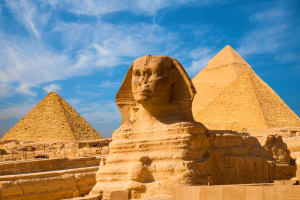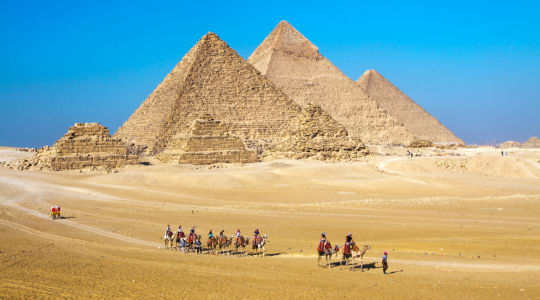The Giza Pyramids, also known as the Great Pyramids of Giza, are a complex of ancient structures located on the Giza Plateau in Egypt, just outside of Cairo. They are some of the most recognizable and iconic landmarks in the world and are considered to be one of the greatest architectural achievements of all time.
The Giza Pyramids consist of three main pyramids, built for the pharaohs Khufu, Khafre, and Menkaure, as well as several smaller pyramids, temples, and other structures. The largest pyramid, the Pyramid of Khufu, also known as the Great Pyramid, is the largest and was the tallest structure in the world for more than 3,800 years. It is estimated that it took over 20 years to build and required the labor of around 100,000 workers.
The Pyramids of Giza were built during the Old Kingdom period of ancient Egyptian history, between 2589 and 2504 BC. They were originally built as tombs for the pharaohs and were intended to protect the pharaoh's body and possessions for eternity. The pyramids were constructed using large, precisely cut stone blocks and were originally covered in a smooth layer of limestone. Over time, this limestone has been removed, leaving the rough, stepped appearance that is seen today.
Today, the Giza Pyramids are a popular tourist destination and attract millions of visitors each year. Visitors can enter some of the pyramids and explore the various chambers and passageways within. The site is also home to the Great Sphinx, a large statue with the body of a lion and the head of a human, which is believed to have been built during the same time period as the pyramids.
Explore Near Giza pyramids
Discover 5 attractions, 5 cities, and 2 airports within 75km. Perfect for planning day trips, finding connecting flights, or discovering new destinations to explore during your visit.
Nearby Attractions & Places to Visit
5 destinations within 490m - 14.7km from your location





Nearby Cities Worth Exploring
5 destinations within 6.5km - 14.1km from your location
Airports Near Giza pyramids
2 destinations within 27.1km - 29.5km from your location
Cross-Border Adventures Near Giza pyramids
Discover cross-border adventures near Giza pyramids. Explore neighboring countries with similar attractions and extend your travel experience across borders.













